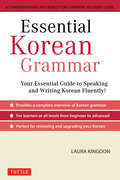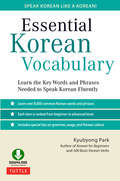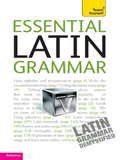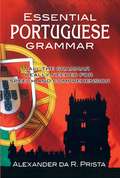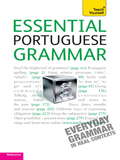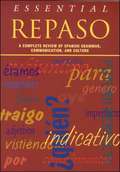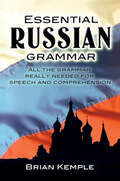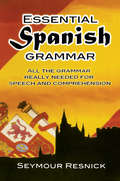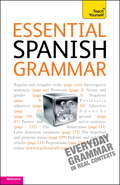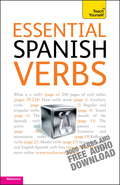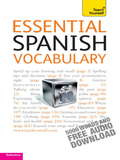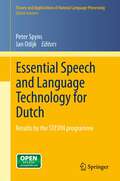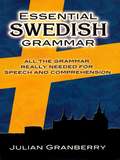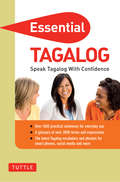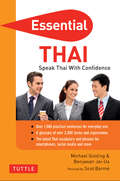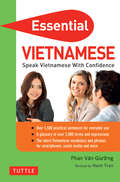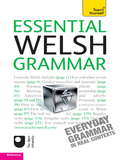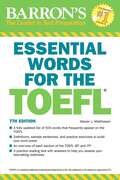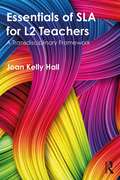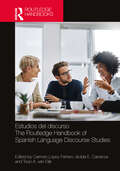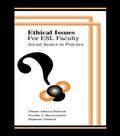- Table View
- List View
Essential Korean Grammar
by Laura KingdonDo you want your Korean language skills to shine? Then Essential Korean Grammar offers exactly what you need to finally understand and express which grammar option is best. Having a solid understanding of grammar is essential to effectively learn Korean. Essential Korean Grammar gives you excellent examples that lay out the best grammar options for communicating, and when to use each option. The grammar items are cleverly rated so you can determine what's most useful for you to study, based on your Korean knowledge level and your plans. There is a star rating system, from 5 stars ("critical"; with these under your belt you can communicate almost everything you need to say) to 1 star (don't worry about this unless there's some reason you need to know it—for example, the TOPIK exam). Essential Korean Grammar is a toolbox to help you form correct and natural-sounding sentences, and determine which grammar you need for reading or writing Korean. It details: How to combine grammar points with each type of word. How it is similar to and different from related grammar points. Commonly used expressions. Things for learners to watch out for. The example sentences for each grammar point use simple vocabulary that even a beginner will know. A perfect supplement to any Korean language textbook!
Essential Korean Vocabulary
by Kyubyong ParkThis user-friendly Korean language book pushes readers towards greater fluency in spoken and written Korean. With Essential Korean Vocabulary you will learn to speak Korean the way that Koreans do by learning key words and expressions they use everyday in their natural contexts. You'll also learn closely-related vocabulary together, which will help you remember and use a wider vocabulary. Each word in this book is clearly explained and useful sentences are given to demonstrate how it's used. Author Kyubyong Park also provides tips on Korean grammar and modern colloquial usage in South Korea, so you can learn to speak like a native speaker. Essential Korean Vocabulary presents the 6,000 most common Korean words and phrases organized into 22 different subject areas. Beginning students can focus on the most basic items, which are clearly marked. As you progress to greater fluency, you can pick up more complicated words and expressions to bring your overall vocabulary and understanding of Korean up to an advanced level. With Essential Korean Vocabulary, you will: Upgrade your Korean skills in stages by learning the most useful words in sequence along a graded spectrum from beginner to advanced. Learn how real Koreans speak in authentic sentences by native speakers. Get special tips about tone, nuance, and correct usage of terms. Learn the vocabulary needed to pass standard Korean proficiency tests. The enclosed audio disc of recordings by native Korean speakers is a great way to learn Korean and helps you to master authentic Korean pronunciation, making you a better Korean speaker!
Essential Latin Grammar: Teach Yourself
by Dr Gregory KlyveEssential Latin Grammar will help you get more out of your study of Latin. Essential Latin Grammar is an up-to-date introduction to Latin grammar. You don't need to know a lot about grammar before you start. Everything is explained simply and there are lots of examples to illustrate each point. Unlike more traditional grammars, Essential Latin Grammar is structured so that you can look up language forms according to their meaning, even if you don't know the grammatical term for them. Essential Latin Grammar will help you to understand and manipulate Latin grammar with confidence because:- you need no prior knowledge of grammatical terminology to use it;- the approach is accessible and supportive;- the examples are clear and in context;- exercises help you practise every point.Now in a brand new edition with new, easy-to-follow page design and interactive on-line features:NOT GOT MUCH TIME?One, five and ten-minute introductions to key principles to get you started.AUTHOR INSIGHTSLots of instant help with common problems and quick tips for success, based on the author's many years of experience.USEFUL VOCABULARYEasy to find and learn, to build a solid foundation for speaking.EXTEND YOUR KNOWLEDGEExtra online articles at: www.teachyourself.com to give you a richer understanding of the culture of Ancient Rome.
Essential Latin Grammar: Teach Yourself
by Gregory KlyveEssential Latin Grammar will help you get more out of your study of Latin. Essential Latin Grammar is an up-to-date introduction to Latin grammar. You don't need to know a lot about grammar before you start. Everything is explained simply and there are lots of examples to illustrate each point. Unlike more traditional grammars, Essential Latin Grammar is structured so that you can look up language forms according to their meaning, even if you don't know the grammatical term for them. Essential Latin Grammar will help you to understand and manipulate Latin grammar with confidence because: - you need no prior knowledge of grammatical terminology to use it; - the approach is accessible and supportive; - the examples are clear and in context; - exercises help you practise every point. Now in a brand new edition with new, easy-to-follow page design and interactive on-line features: NOT GOT MUCH TIME? One, five and ten-minute introductions to key principles to get you started. AUTHOR INSIGHTS Lots of instant help with common problems and quick tips for success, based on the author's many years of experience. USEFUL VOCABULARY Easy to find and learn, to build a solid foundation for speaking. EXTEND YOUR KNOWLEDGE Extra online articles at: www.teachyourself.com to give you a richer understanding of the culture of Ancient Rome.
Essential Portuguese Grammar
by Alexander Da PristaThis is the first Portuguese grammar designed specifically for adults with limited learning time, who have as their objective simple, everyday communication. The author covers the most important points of Portuguese grammar in the clearest possible way, concentrating upon the expressions that you would be most likely to use. All grammatical rules are illustrated with phrases and sentences that you can incorporate directly into your working vocabulary, and hints are generously sprinkled throughout, showing you how to replace difficult constructions with simpler ones.Constantly drawing comparisons with English construction, it presents in logical order all the major aspects of Portuguese grammar: word order, forming questions, nouns and articles, adjectives and adverbs, possessives, demonstrative adjectives and pronouns, how to form negatives, personal pronouns, conjunctions and prepositions, how to conjugate verbs in the major tenses, prepositions and infinitives, and so on.This grammar does not assume prior knowledge of either Portuguese grammar or of grammatical terms: one section is devoted to the definition of all grammatical terms used in the book.This is not a simplified study, but rather a selected grammar for adult use that points out many time-saving short cuts. It can be used alone either as a beginner or as a refresher course in Portuguese grammar or it can be an ideal supplement to a phrase book or record course for home study or class use. Contains four appendices covering regular conjugations, orthographic-changing verbs, and irregular verbs. Glossary of grammatical terms. Index.
Essential Portuguese Grammar: Teach Yourself
by Sue Tyson-WardEssential Portuguese Grammar will help you get more out of your study of Portuguese. Essential Portuguese Grammar is an up-to-date introduction to Portuguese grammar. You don't need to know a lot about grammar before you start. Everything is explained simply and there are lots of examples to illustrate each point. Unlike more traditional grammars, Essential Portuguese Grammar is structured so that you can look up language forms according to what you want to say, even if you don't know the grammatical term for them. If you already know some grammar, then you can use the 'reference grammar' section at the back of the book to look up the points you need.The course consists of 46 units illustrating the various uses to which the language can be put, for example, giving instructions or talking about the recent past. The more traditional reference grammar deals with grammatical structures, such as the imperative or the perfect tense. All grammatical terms are explained in the glossary at the back of the book. Each unit contains exercises for you to practise what you have learnt and there is a key at the back of the book for you to check your answers. The new page design in this edition means that the book is even easier to use and the main headings are in English so that you can find your way around the book quickly. This edition contains a 'taking it further' section which will direct you to further sources of real Portuguese. Essential Portuguese Grammar will help you to understand and manipulate Portuguese grammar with confidence because:- you need no prior knowledge of grammatical terminology to use it;- the approach is accessible and supportive;- the examples are clear and in context;- exercises help you practise every point.Now in a brand new edition with new, easy-to-follow page design:
Essential Portuguese Grammar: Teach Yourself
by Sue Tyson-WardEssential Portuguese Grammar will help you get more out of your study of Portuguese. Essential Portuguese Grammar is an up-to-date introduction to Portuguese grammar. You don't need to know a lot about grammar before you start. Everything is explained simply and there are lots of examples to illustrate each point. Unlike more traditional grammars, Essential Portuguese Grammar is structured so that you can look up language forms according to what you want to say, even if you don't know the grammatical term for them. If you already know some grammar, then you can use the 'reference grammar' section at the back of the book to look up the points you need.The course consists of 46 units illustrating the various uses to which the language can be put, for example, giving instructions or talking about the recent past. The more traditional reference grammar deals with grammatical structures, such as the imperative or the perfect tense. All grammatical terms are explained in the glossary at the back of the book. Each unit contains exercises for you to practise what you have learnt and there is a key at the back of the book for you to check your answers. The new page design in this edition means that the book is even easier to use and the main headings are in English so that you can find your way around the book quickly. This edition contains a 'taking it further' section which will direct you to further sources of real Portuguese. Essential Portuguese Grammar will help you to understand and manipulate Portuguese grammar with confidence because:- you need no prior knowledge of grammatical terminology to use it;- the approach is accessible and supportive;- the examples are clear and in context;- exercises help you practise every point.Now in a brand new edition with new, easy-to-follow page design:
Essential Repaso: A Complete Review of Spanish Grammar, Communication, and Culture
by National Textbook CompanyAn ideal review and practice tool for intermediate through to advanced learners of Spanish. Organized into 28 grammar lessons, it offers clear concise explanations with examples of everyday usage which encourage students to see grammar as a stepping stone to communication.
Essential Russian Grammar (Dover Language Guides Essential Grammar)
by Brian KempleDesigned for adults with limited learning time, this concise and easy-to-use guide enables language students to grasp the fundamentals of Russian quickly and easily. Focusing on the grammar needed to speak and understand the language, the text emphasizes comprehension rather than memorization of grammatical constructions.Author Brian Kemple uses an efficient and systematic approach to instructing students in the use of all the grammar that's needed for everyday speech and comprehension. Simple phrases are accompanied by clear explanations of parts of speech, use of the comparative and superlative degrees, word order, pronunciation, negation and more. A useful section of practical phrases and a glossary of grammatical terms round out this excellent, inexpensive guide.Perfect for independent study or as an adjunct to a language course, Essential Russian Grammar is ideal for students, business people, tourists or anyone planning to visit Russia.
Essential Spanish Grammar
by Seymour ResnickThis Spanish grammar has been designed specifically for the adult with limited learning time. It covers the most important points of Spanish grammar in the clearest possible way, concentrating on the expressions that you would be most likely to use. All rules are illustrated with common phrases, and hints are included throughout the book on how to replace difficult constructions with simpler ones.All the major aspects of Spanish grammar are presented in logical order: vocabulary and vocabulary building; word order; how to turn a positive sentence into a negative one; how to form questions; nouns; pronouns; adjectives; adverbs; how to conjugate verbs in the major tenses; how to use auxiliary verbs; prepositions and infinitives; useful expressions; and vocabulary tips. One section is devoted to the definition of all grammatical terms used throughout the book.Not a simplified grammar, this is a selected grammar for adult use. It can be used alone, either as an introductory course or as a refresher, or as a supplement to a record course. Its cognate list of more than 2500 words which are either the same or nearly the same in Spanish and English offers probably the easiest way for you to build your vocabulary, for you will discover that you have already been using very many words that with a slight change in pronunciation are already good Spanish. This is the only place where this useful teaching device is available.
Essential Spanish Grammar: Teach Yourself
by Juan Kattan-IbarraIs this the right course for me?Essential Spanish Grammar will help you get more out of your study of Spanish. Essential Spanish Grammar is an up-to-date introduction to Spanish grammar. You don't need to know a lot about grammar before you start. Everything is explained simply and there are lots of examples to illustrate each point. Unlike more traditional grammars, Essential Spanish Grammar is structured so that you can look up language forms according to what you want to say, even if you don't know the grammatical term for them. If you already know some grammar, then you can use the 'reference grammar' section at the back of the book to look up the points you need.The course consists of 23 units illustrating the various uses to which the language can be put, for example, giving instructions or talking about the recent past. The more traditional reference grammar deals with grammatical structures, such as the imperative or the perfect tense. All grammatical terms are explained in the glossary at the back of the book. Each unit contains exercises for you to practise what you have learnt and there is a key at the back of the book for you to check your answers. The new page design in this edition means that the book is even easier to use and the main headings are in English so that you can find your way around the book quickly. This edition contains a 'taking it further' section which will direct you to further sources of real Spanish. Essential Spanish Grammar will help you to understand and manipulate Spanish grammar with confidence because:- you need no prior knowledge of grammatical terminology to use it;- the approach is accessible and supportive;- the examples are clear and in context;- exercises help you practise every point.Learn effortlessly with a new, easy-to-follow page design and interactive features:Not got much time?One, five and ten-minute introductions to key principles to get you started.Author insightsLots of instant help with common problems and quick tips for success, based on the author's many years of experience.Useful vocabularyEasy to find and learn, to build a solid foundation for speaking.End-of-unit summaries and online testsSummaries and tests to help you keep track of your progress.Extend your knowledgeExtra online articles to give you a richer understanding of the culture and history of Spain.
Essential Spanish Verbs: Teach Yourself
by Maria Rosario HollisEssential Spanish Verbs is the course for you if you need help with your study of Spanish. This fully revised edition of our best-selling course now comes with free downloadable audio support containing hints on how to learn verbs effectively. The aim of this book is to help you improve your command of Spanish by focusing on one aspect of language learning that invariably causes difficulties - verbs and the way they behave. Whether you are a complete beginner or a relatively advanced learner, you can consult the book when you need to know the form of a verb quickly. The introductory section gives you a complete overview of Spanish verbs and how they work in the various tenses. Essential Spanish Verbs contains: - full coverage of the main tenses for 200 frequently used Spanish verbs arranged alphabetically for quick and easy reference - examples of the verbs in everyday use, with colloquial expressions and words sharing the same origin - a Spanish-English verb list of approximately 3000 verbs with details of the patterns they follow - an English- Spanish verb list giving the most frequently used English verbs in Spanish with details of the patterns they follow - free downloadable audio support with hints on how to learn verbs Learn effortlessly with a new, easy-to-read page design and interactive features: NOT GOT MUCH TIME? One, five and ten-minute introductions to key principles to get you started. AUTHOR INSIGHTS Lots of instant help with common problems and quick tips for success, based on the author's many years of experience. USEFUL VOCABULARY Easy to find and learn, to build a solid foundation for speaking. ONLINE TESTS Tests to help you keep track of your progress. Download our free app, Teach Yourself Library, from the App Store or Google Play to access the free audio.
Essential Spanish Vocabulary: Teach Yourself
by Mike ZolloEssential Spanish Vocabulary is the course for you if you need help with your study of Spanish. This fully revised edition of our best-selling course now comes with free downloadable audio support containing hints on how to learn vocabulary effectively.Unlike a phrasebook or a dictionary, Essential Spanish Vocabulary will take your existing knowledge and build on it systematically and organically, so that you will increase your vocabulary and at the same time expand your range of expression.At the beginning of the book there is a section to help you with your pronunciation, followed by a short and simple grammar summary.The main part of the book is arranged in topics, such as 'Work', 'Travel and Accommodation' and 'Food and Drink', and concentrates on the vital and most current words and expressions, listing those which you might already know and then extending the coverage to teach you those you probably do not know.Finally, the downloadable audio recording will give you hints on how to increase your vocabulary effortlessly.This is an ideal companion if you are a language student or if you are wanting a systematic, easy-to-use tool to increase the range of your vocabulary and improve your ability to express yourself in a wide variety of situations, either on holiday or on a business trip. Learn effortlessly with a new, easy-to-read page design and interactive features: NOT GOT MUCH TIME?One, five and ten-minute introductions to key principles to get you started.AUTHOR INSIGHTSLots of instant help with common problems and quick tips for success, based on the author's many years of experience.END-OF-UNIT SUMMARIES AND ONLINE TESTSSummaries and tests to help you consolidate and keep track of your progress.EXTEND YOUR KNOWLEDGEExtra online articles at: www.teachyourself.com to give you a richer understanding of the culture and history of Spain.
Essential Spanish Vocabulary: Teach Yourself
by Mike ZolloEssential Spanish Vocabulary is the course for you if you need help with your study of Spanish. This fully revised edition of our best-selling course now comes with free downloadable audio support containing hints on how to learn vocabulary effectively.Unlike a phrasebook or a dictionary, Essential Spanish Vocabulary will take your existing knowledge and build on it systematically and organically, so that you will increase your vocabulary and at the same time expand your range of expression.At the beginning of the book there is a section to help you with your pronunciation, followed by a short and simple grammar summary.The main part of the book is arranged in topics, such as 'Work', 'Travel and Accommodation' and 'Food and Drink', and concentrates on the vital and most current words and expressions, listing those which you might already know and then extending the coverage to teach you those you probably do not know.Finally, the downloadable audio recording will give you hints on how to increase your vocabulary effortlessly.This is an ideal companion if you are a language student or if you are wanting a systematic, easy-to-use tool to increase the range of your vocabulary and improve your ability to express yourself in a wide variety of situations, either on holiday or on a business trip. Learn effortlessly with a new, easy-to-read page design and interactive features: NOT GOT MUCH TIME?One, five and ten-minute introductions to key principles to get you started.AUTHOR INSIGHTSLots of instant help with common problems and quick tips for success, based on the author's many years of experience.END-OF-UNIT SUMMARIES AND ONLINE TESTSSummaries and tests to help you consolidate and keep track of your progress.EXTEND YOUR KNOWLEDGEExtra online articles at: www.teachyourself.com to give you a richer understanding of the culture and history of Spain.
Essential Speech and Language Technology for Dutch: Results by the STEVIN-programme (Theory and Applications of Natural Language Processing #14)
by Peter Spyns Linde Van Bosch Jan OdijkThe book provides an overview of more than a decade of joint R&D efforts in the Low Countries on HLT for Dutch. It not only presents the state of the art of HLT for Dutch in the areas covered, but, even more importantly, a description of the resources (data and tools) for Dutch that have been created are now available for both academia and industry worldwide. The contributions cover many areas of human language technology (for Dutch): corpus collection (including IPR issues) and building (in particular one corpus aiming at a collection of 500M word tokens), lexicology, anaphora resolution, a semantic network, parsing technology, speech recognition, machine translation, text (summaries) generation, web mining, information extraction, and text to speech to name the most important ones. The book also shows how a medium-sized language community (spanning two territories) can create a digital language infrastructure (resources, tools, etc.) as a basis for subsequent R&D. At the same time, it bundles contributions of almost all the HLT research groups in Flanders and the Netherlands, hence offers a view of their recent research activities. Targeted readers are mainly researchers in human language technology, in particular those focusing on Dutch. It concerns researchers active in larger networks such as the CLARIN, META-NET, FLaReNet and participating in conferences such as ACL, EACL, NAACL, COLING, RANLP, CICling, LREC, CLIN and DIR ( both in the Low Countries), InterSpeech, ASRU, ICASSP, ISCA, EUSIPCO, CLEF, TREC, etc. In addition, some chapters are interesting for human language technology policy makers and even for science policy makers in general.
Essential Swedish Grammar (Dover Language Guides Essential Grammar)
by Julian GranberryDesigned for those with limited learning time, this book is not a condensed outline of all aspects of Swedish grammar. Rather, it focuses on simple everyday communication, helping students use previously learned phrases and vocabulary more effectively and with great versatility.After introductory discussions of vocabulary building, word order and the formation of negative sentences and questions, the author offers concise, easy-to-follow coverage of the parts of speech. Numerous examples are included to demonstrate each rule of grammatical usage with the emphasis throughout on simple constructions rather than complicated ones. A selection of useful expressions and a glossary of grammatical terms round out this excellent, inexpensive guide, perfect for self-study or as an adjunct to a language course.Whether you are just beginning the study of Swedish or wish to review the fundamentals, Essential Swedish Grammar enables you to learn in a systematic way, at your own rate, guided by your own requirements and interests.
Essential Tagalog
by Renato PerdonStart speaking Tagalog today with Essential Tagalog! This easy phrase book gives you all the words and phrases you need in the Philippines or Tagalog-speaking environments. Even with no prior experience speaking Tagalog, you'll find everything you need in this simple guide:Easy to understand pronunciation notesOver 1,500 essential Tagalog sentences and phrases needed in everyday interactions in restaurants and shops, at work, in a doctor's office, or with friendsA glossary of 2,000 key words and phrases, including words for smart phones, the internet, social networking, and more!Special etiquette notes to help you make perfect first impressions and avoid awkward mistakesA short grammar overview that shows you how to make your own sentences and questionsLearn Tagalog today! It's easy!
Essential Thai
by Michael Golding Benjawan Jai-UaThis portable, user-friendly Thai language guide and phrasebook is the cheapest and easiest way to learn Thai before and during your trip. If you only want one Thai language book--Essential Thai is the way to go. Part of Tuttle Publishing's Essential Phrasebooks Series, it is a great first introduction and beginner guide to the language of Thailand and is also designed as a great Thai phrasebook, making it the most versatile Thai language learning tool on the market. Essential Thai presents the practical language of everyday interactions by incorporating fundamental sentences used when meeting people, starting conversations, and asking and replying to questions in Thai, as well as a basic grammar and pronunciation guide to help you get started speaking Thai right away. In addition, language involving terms and phrases covering the latest technology devices, using social media, and tips on the essentials of travel like arranging accommodations, dining out, dealing with transportation and emergencies, is also effectively covered in extraordinary detail. Essential Thai includes: Over 1,500 essential sentences for everyday use. A glossary containing over 2,000 terms and expressions. A handy format for finding the information you need quickly and easily. Latest Thai vocabulary and technology terms
Essential Vietnamese
by Phan Van Giuong Hanh TranThis is a compact and user-friendly Vietnamese Phrasebook and guide to the Vietnamese language, Essential Vietnamese contains basic Vietnamese vocabulary and grammar necessary for communicating in Vietnamese.Learning Vietnamese and engaging in Vietnamese conversation is made easier, more accessible, and more enjoyable in this new Vietnamese phrase book, Essential Vietnamese. One of the best resources to learn Vietnamese, this book presents practical language of everyday interactions by incorporating fundamental sentences used when meeting people, starting conversations, and asking and replying to questions in Vietnamese, as well as a basic grammar and pronunciation guide to help you start speaking Vietnamese right away.In addition, language involving terms and phrases covering the latest technology devices, using social media, and tips on the essentials of travel like arranging accomodations, dining out, dealing with transportation and emergencies, is also effectively covered in extraordinary detail.Essential Vietnamese includes: Over 1,500 essential sentences for everyday use A glossary containing over 2,000 terms and expressions A handy format for finding the information you need quickly and easily Latest Vietnamese vocabulary and phrases for smart phones, social media and more
Essential Welsh Grammar: Teach Yourself
by Christine JonesEssential Welsh Grammar will help you get more out of your study of Welsh. Essential Welsh Grammar is an up-to-date introduction to Welsh grammar. You don't need to know a lot about grammar before you start. Everything is explained simply and there are lots of examples to illustrate each point. Unlike more traditional grammars, Essential Welsh Grammar is structured so that you can look up language forms according to what you want to say, even if you don't know the grammatical term for them. If you already know some grammar, then you can use the 'reference grammar' section at the back of the book to look up the points you need.The course consists of 27 units illustrating the various uses to which the language can be put, for example, giving instructions or talking about the recent past. The more traditional reference grammar deals with grammatical structures, such as the imperative or the perfect tense. All grammatical terms are explained in the glossary at the back of the book. Each unit contains exercises for you to practise what you have learnt and there is a key at the back of the book for you to check your answers. The new page design in this edition means that the book is even easier to use and the main headings are in English so that you can find your way around the book quickly. This edition contains a 'taking it further' section which will direct you to further sources of real Welsh. Essential Welsh Grammar will help you to understand and manipulate Welsh grammar with confidence because:- you need no prior knowledge of grammatical terminology to use it;- the approach is accessible and supportive;- the examples are clear and in context;- exercises help you practise every point.
Essential Welsh Grammar: Teach Yourself
by Christine JonesEssential Welsh Grammar will help you get more out of your study of Welsh. Essential Welsh Grammar is an up-to-date introduction to Welsh grammar. You don't need to know a lot about grammar before you start. Everything is explained simply and there are lots of examples to illustrate each point. Unlike more traditional grammars, Essential Welsh Grammar is structured so that you can look up language forms according to what you want to say, even if you don't know the grammatical term for them. If you already know some grammar, then you can use the 'reference grammar' section at the back of the book to look up the points you need.The course consists of 27 units illustrating the various uses to which the language can be put, for example, giving instructions or talking about the recent past. The more traditional reference grammar deals with grammatical structures, such as the imperative or the perfect tense. All grammatical terms are explained in the glossary at the back of the book. Each unit contains exercises for you to practise what you have learnt and there is a key at the back of the book for you to check your answers. The new page design in this edition means that the book is even easier to use and the main headings are in English so that you can find your way around the book quickly. This edition contains a 'taking it further' section which will direct you to further sources of real Welsh. Essential Welsh Grammar will help you to understand and manipulate Welsh grammar with confidence because:- you need no prior knowledge of grammatical terminology to use it;- the approach is accessible and supportive;- the examples are clear and in context;- exercises help you practise every point.
Essential Words for the Toefl, 7th edition (Barron's Essential Words Ser.)
by Steven J. MatthiesenThis revised book is specifically designed for ESL students preparing to take the TOEFL and features updated vocabulary that is seen most often on the exam. It includes:Phrases and “purpose” words (for example, define, discuss, claim, etc.) that are used in the speaking and writing sections of the test New words and phrases, since you are often asked to explain the meaning of a phraseLists of vocabulary words with definitions, sample sentences, and practice exercises for 500 need-to-know wordsDetailed advice to help students expand their English language vocabulary, and moreStudents can test their mastery of TOEFL vocabulary by taking the included practice test with answer key, which is designed to help students evaluate their progress, and increase confidence in their vocabulary skills.
Essentials of SLA for L2 Teachers: A Transdisciplinary Framework
by Joan Kelly HallEssentials of SLA for L2 Teachers: A Transdisciplinary Framework presents an accessible and comprehensive account of current understandings of second language acquisition (SLA) geared towards those studying to become L2 teachers. Grounded in the pragmatic and problem-oriented transdisciplinary framework of SLA, this textbook draws connections between SLA research and practices for L2 teaching. It aims to build L2 teacher expertise by strengthening teachers’ understandings of the many facets of L2 learning and their skills for designing transformative learning environments in their teaching contexts. The author includes pedagogical implications and inquiry-based activities in each chapter that engage readers in further explorations of the topics covered in the chapter. Short and straightforward, Essentials of SLA for L2 Teachers is the ideal main resource for SLA courses taught at undergraduate and graduate-level teaching programs.
Estudios del discurso / The Routledge Handbook of Spanish Language Discourse Studies (Routledge Spanish Language Handbooks)
by Carmen López Ferrero Isolda E. Carranza van Dijk, Teun A.Estudios del discurso / The Routledge Handbook of Spanish Language Discourse Studies es un manual internacional que ofrece un panorama abarcador de los Estudios del discurso, con acento en las áreas más relevantes, actuales y de proyección futura en el mundo hispanohablante. Participan en él académicos que son referentes del campo en España, América Latina y Estados Unidos. Esta obra es también ú nica por su extensión y cobertura: contiene 36 cap í tulos organizados en cinco partes que cubren los métodos y teorías de los Estudios del discurso, su relación con otras disciplinas, los vínculos entre discurso, sociedad y cultura en los diversos países hispanohablantes, cuestiones de discurso y comunicación, y estudios aplicados del discurso. Este volumen constituye una obra de referencia que refleja el dinamismo y la productividad de los Estudios del discurso en lengua española. Así pues, es un recurso incomparable para quienes se ocupan del discurso en su actividad académica o profesional. Gracias a la ejemplificación con casos analizados, es útil para estudiantes universitarios y docentes de grado y posgrado. Por su parte, los investigadores de diversas ramas de las Humanidades y las Ciencias Sociales encuentran una estupenda puesta al día sobre los avances y debates en este campo. Estudios del discurso / The Routledge Handbook of Spanish Language Discourse Studies is an international handbook which offers an encompassing panorama of Discourse Studies with an emphasis on the most relevant, up-to-date and promising areas in the Spanish-speaking world. The contributors are leading scholars in the field in Spain, Latin America and the United States. This book is also unique in its scope: Its 36 chapters are organized in five parts which deal with the methods and theories of Discourse Studies, its relationship with other disciplines, the links between discourse, society and culture in the various Spanish-speaking countries, issues of discourse and communication, and applied studies of discourse. This volume constitutes an inescapable reference that reflects the dynamism and the productivity of Discourse Studies in Spanish. For this reason, it is an incomparable resource for those with academic or professional interests in discourse. Thanks to the illustration with analysed cases, it is useful for undergraduate and graduate students and teachers. In addition, researchers in various branches of the Humanities and the Social Sciences find here a vibrant update on the advances and debates in this field.
Ethical Issues for Esl Faculty: Social Justice in Practice
by Johnnie Johnson Hafernik Stephanie Vandrick Dorothy S. MesserschmittThis book explicitly addresses ethical dilemmas and issues that post-secondary ESL faculty commonly encounter and examines them in the framework of social justice concerns. Ethics is defined broadly, to include responsibilities and obligations to students inside and outside the classroom, as well to colleagues, educational institutions, the TESL profession, and society as a whole. Scenarios in each chapter provide realistic and compelling situations for reflection and discussion. The authors then set out the issues raised, relate them to the classroom environment, and offer opportunities to examine them in a variety of contexts and to consider possible solutions to the dilemmas. Issues include testing, plagiarism, technology, social and political issues affecting students and the classroom, gift-giving, curriculum decisions, disruptive students, institutional constraints, academic freedom, gender, class, and power. Busy classroom instructors will find this book accessible, thought-provoking, and relevant to their daily work situations. It is not intended as a theoretical treatment of ethics and social justice in ESL, nor does it propose that ESL faculty teach morals or ethics to students. Rather, it is designed as a concise, practical introduction to ethical practice for both new and experienced ESL faculty in post-secondary teaching situations in the United States, for others interested in the ESL classroom, and as a text for TESL classes and seminars. Ethical Issues for ESL Faculty: *maps new territory in the field--ethical issues in TESL, particularly as encountered by post-secondary classroom teachers, are not often discussed in ESL publications; *makes the complex issues of ethics in the context of social justice accessible to TESL practitioners; and *includes useful resources, such as additional scenarios for discussion, an extensive reference list, and selected ethics-related Web sites.
